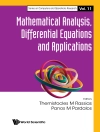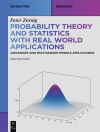Computational Fractional Dynamical Systems
A rigorous presentation of different expansion and semi-analytical methods for fractional differential equations
Fractional differential equations, differential and integral operators with non-integral powers, are used in various science and engineering applications. Over the past several decades, the popularity of the fractional derivative has increased significantly in diverse areas such as electromagnetics, financial mathematics, image processing, and materials science. Obtaining analytical and numerical solutions of nonlinear partial differential equations of fractional order can be challenging and involve the development and use of different methods of solution.
Computational Fractional Dynamical Systems: Fractional Differential Equations and Applications presents a variety of computationally efficient semi-analytical and expansion methods to solve different types of fractional models. Rather than focusing on a single computational method, this comprehensive volume brings together more than 25 methods for solving an array of fractional-order models. The authors employ a rigorous and systematic approach for addressing various physical problems in science and engineering.
- Covers various aspects of efficient methods regarding fractional-order systems
- Presents different numerical methods with detailed steps to handle basic and advanced equations in science and engineering
- Provides a systematic approach for handling fractional-order models arising in science and engineering
- Incorporates a wide range of methods with corresponding results and validation
Computational Fractional Dynamical Systems: Fractional Differential Equations and Applications is an invaluable resource for advanced undergraduate students, graduate students, postdoctoral researchers, university faculty, and other researchers and practitioners working with fractional and integer order differential equations.
Table of Content
Preface
Acknowledgments
About the Authors
Introduction to Fractional Calculus
1.1. Introduction
1.2. Birth of fractional calculus
1.3. Useful mathematical functions
1.3.1. The gamma function
1.3.2. The beta function
1.3.3. The Mittag-Leffler function
1.3.4. The Mellin-Ross function
1.3.5. The Wright function
1.3.6. The error function
1.3.7. The hypergeometric function
1.3.8. The H-function
1.4. Riemann–Liouville fractional integral and derivative
1.5. Caputo fractional derivative
1.6. Grünwald-Letnikov fractional derivative and integral
1.7. Riesz fractional derivative and integral
1.8. Modified Riemann-Liouville derivative
1.9. Local fractional derivative
1.9.1. Local fractional continuity of a function
1.9.2. Local fractional derivative
References
Recent Trends in Fractional Dynamical Models and Mathematical Methods
2.1. Introduction
2.2. Fractional calculus: A generalization of integer-order calculus
2.3. Fractional derivatives of some functions and their graphical illustrations
2.4. Applications of fractional calculus
2.4.1. N.H. Abel and Tautochronous problem
2.4.2. Ultrasonic wave propagation in human cancellous bone
2.4.3. Modeling of speech signals using fractional calculus
2.4.4. Modeling the cardiac tissue electrode interface using fractional calculus
2.4.5. Application of fractional calculus to the sound waves propagation in rigid porous Materials
2.4.6. Fractional calculus for lateral and longitudinal control of autonomous vehicles
2.4.7. Application of fractional calculus in the theory of viscoelasticity
2.4.8. Fractional differentiation for edge detection
2.4.9. Wave propagation in viscoelastic horns using a fractional calculus rheology model
2.4.10. Application of fractional calculus to fluid mechanics
2.4.11. Radioactivity, exponential decay and population growth
2.4.12. The Harmonic oscillator
2.5. Overview of some analytical/numerical methods
2.5.1. Fractional Adams–Bashforth/Moulton methods
2.5.2. Fractional Euler method
2.5.3. Finite difference method
2.5.4. Finite element method
2.5.5. Finite volume method
2.5.6. Meshless method
2.5.7. Reproducing kernel Hilbert space method
2.5.8. Wavelet method
2.5.9. The Sine-Gordon expansion method
2.5.10. The Jacobi elliptic equation method
2.5.11. The generalized Kudryashov method
References
Adomian Decomposition Method (ADM)
3.1. Introduction
3.2. Basic Idea of ADM
3.3. Numerical Examples
References
Adomian Decomposition Transform Method
4.1. Introduction
4.2. Transform methods for the Caputo sense derivatives
4.3. Adomian decomposition Laplace transform method (ADLTM)
4.4. Adomian decomposition Sumudu transform method (ADSTM)
4.5. Adomian decomposition Elzaki transform method (ADETM)
4.6. Adomian decomposition Aboodh transform method (ADATM)
4.7. Numerical Examples
4.7.1. Implementation of ADLTM
4.7.2. Implementation of ADSTM
4.7.3. Implementation of ADETM
4.7.4. Implementation of ADATM
References
Homotopy Perturbation Method (HPM)
5.1. Introduction
5.2. Procedure of HPM
5.3. Numerical examples
References
Homotopy Perturbation Transform Method
6.1. Introduction
6.2. Transform methods for the Caputo sense derivatives
6.3. Homotopy perturbation Laplace transform method (HPLTM)
6.4. Homotopy perturbation Sumudu transform method (HPSTM)
6.5. Homotopy perturbation Elzaki transform method (HPETM)
6.6. Homotopy perturbation Aboodh transform method (HPATM)
6.7. Numerical Examples
6.7.1. Implementation of HPLTM
6.7.2. Implementation of HPSTM
6.7.3. Implementation of HPETM
6.7.4. Implementation of HPATM
References
Fractional Differential Transform Method
7.1. Introduction
7.2. Fractional differential transform method
7.3. Illustrative Examples
References
Fractional Reduced Differential Transform Method
8.1. Introduction
8.2. Description of FRDTM
8.3. Numerical Examples
References
Variational Iterative Method
9.1. Introduction
9.2. Procedure for VIM
9.3. Examples
References
Method of Weighted Residuals
10.1. Introduction
10.2. Collocation method
10.3. Least-square method
10.4. Galerkin method
10.5. Numerical Examples
References
Boundary Characteristics Orthogonal Polynomials
11.1. Introduction
11.2. Gram–Schmidt orthogonalization procedure
11.3. Generation of BCOPs
11.4. Galerkin method with BCOPs
11.5. Least-Square method with BCOPs
11.6. Application Problems
References
Residual Power Series Method
12.1. Introduction
12.2. Theorems and lemma related to RPSM
12.3. Basic idea of RPSM
12.4. Convergence Analysis
12.5. Examples
References
Homotopy Analysis Method
13.1. Introduction
13.2. Theory of homotopy analysis method
13.3. Convergence theorem of HAM
13.4. Test Examples
References
Homotopy Analysis Transform Method
14.1. Introduction
14.2. Transform methods for the Caputo sense derivative
14.3. Homotopy analysis Laplace transform method (HALTM)
14.4. Homotopy analysis Sumudu transform method (HASTM)
14.5. Homotopy analysis Elzaki transform method (HAETM)
14.6. Homotopy analysis Aboodh transform method (HAATM)
14.7. Numerical Examples
14.7.1. Implementation of HALTM
14.7.2. Implementation of HASTM
14.7.3. Implementation of HAETM
14.7.4. Implementation of HAATM
References
q-Homotopy Analysis Method
15.1. Introduction
15.2. Theory of q-HAM
15.3. Illustrative Examples
References
q-Homotopy Analysis transform Method
16.1. Introduction
16.2. Transform methods for the Caputo sense derivative
16.3. q-homotopy analysis Laplace transform method (q-HALTM)
16.4. q-homotopy analysis Sumudu transform method (q-HASTM)
16.5. q-homotopy analysis Elzaki transform method (q-HAETM)
16.6. q-homotopy analysis Aboodh transform method (q-HAATM)
16.7. Test Problems
16.7.1. Implementation of q-HALTM
16.7.2. Implementation of q-HASTM
16.7.3. Implementation of q-HAETM
16.7.4. Implementation of q-HAATM
References
(G’/G)-Expansion Method
17.1. Introduction
17.2. Description of the (G’/G)-expansion method
17.3. Application Problems
References
(G’/G^2)-Expansion Method
18.1. Introduction
18.2. Description of the (G’/G^2)-expansion method
18.3. Numerical Examples
References
(G’/G, 1/G)-Expansion Method
19.1. Introduction
19.2. Algorithm of the (G’/G, 1/G)-expansion method
19.3. Illustrative Examples
References
The modified simple equation method
20.1. Introduction
20.2. Procedure of the modified simple equation method
20.3. Application Problems
References
Sine-Cosine Method
21.1. Introduction
21.2. Details of Sine-Cosine method
21.3. Numerical Examples
References
Tanh Method
22.1. Introduction
22.2. Description of the Tanh method
22.3. Numerical Examples
References
Fractional sub-equation method
23.1. Introduction
23.2. Implementation of the fractional sub-equation method
23.3. Numerical Examples
References
Exp-function Method
24.1. Introduction
24.2. Procedure of the Exp-function method
24.3. Numerical Examples
References
Exp(-φ(ξ))-expansion method
25.1. Introduction
25.2. Methodology of the exp(-φ(ξ))-expansion method
25.3. Numerical Examples
References
Index
About the author
Snehashish Chakraverty, Senior Professor, Department of Mathematics (Applied Mathematics Group), National Institute of Technology Rourkela, Odisha, India.
Rajarama Mohan Jena, Senior Research Fellow, Department of Mathematics, National Institute of Technology Rourkela, Odisha, India.
Subrat Kumar Jena, Senior Research Fellow, Department of Mathematics, National Institute of Technology Rourkela, Odisha, India.












